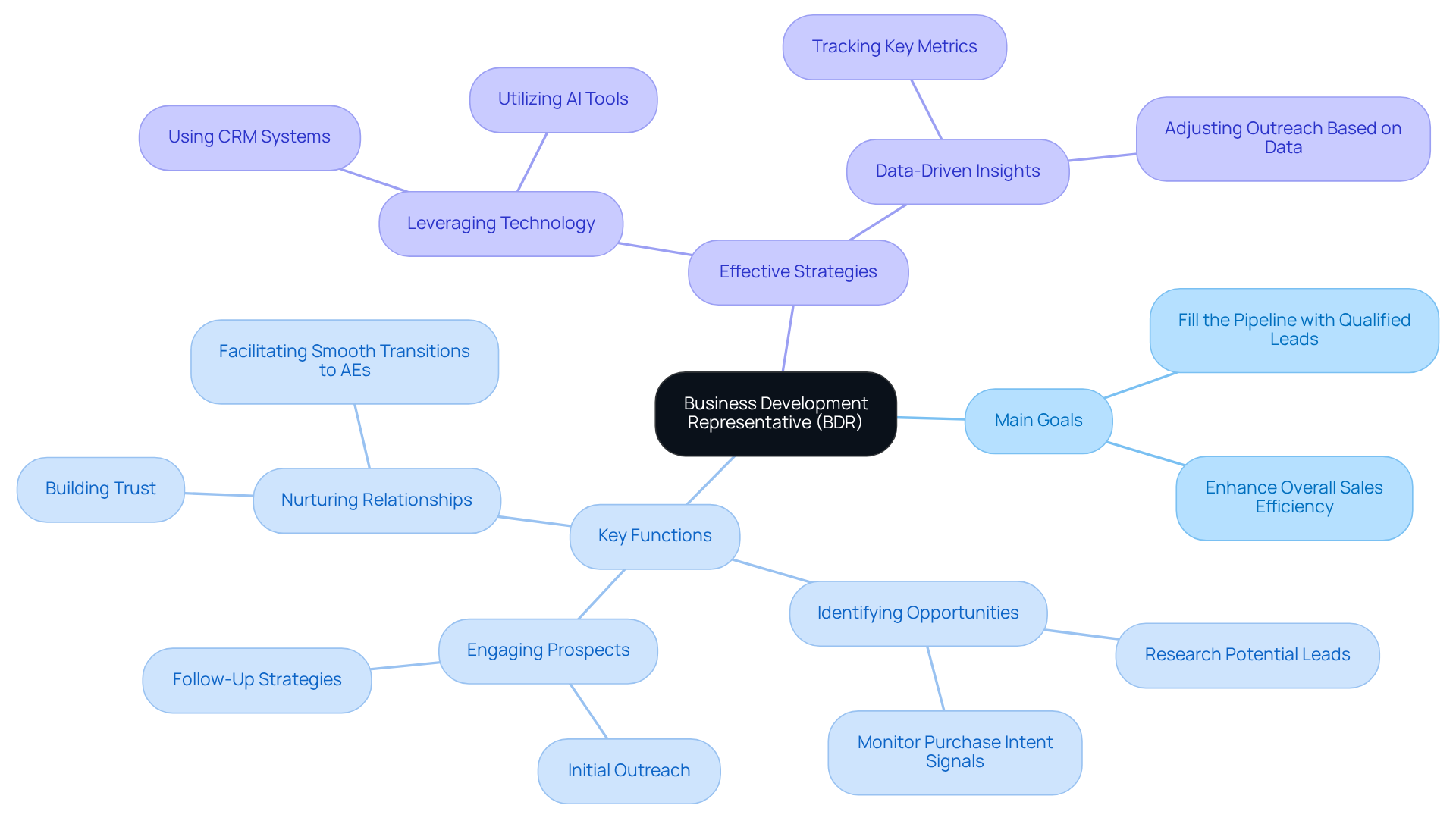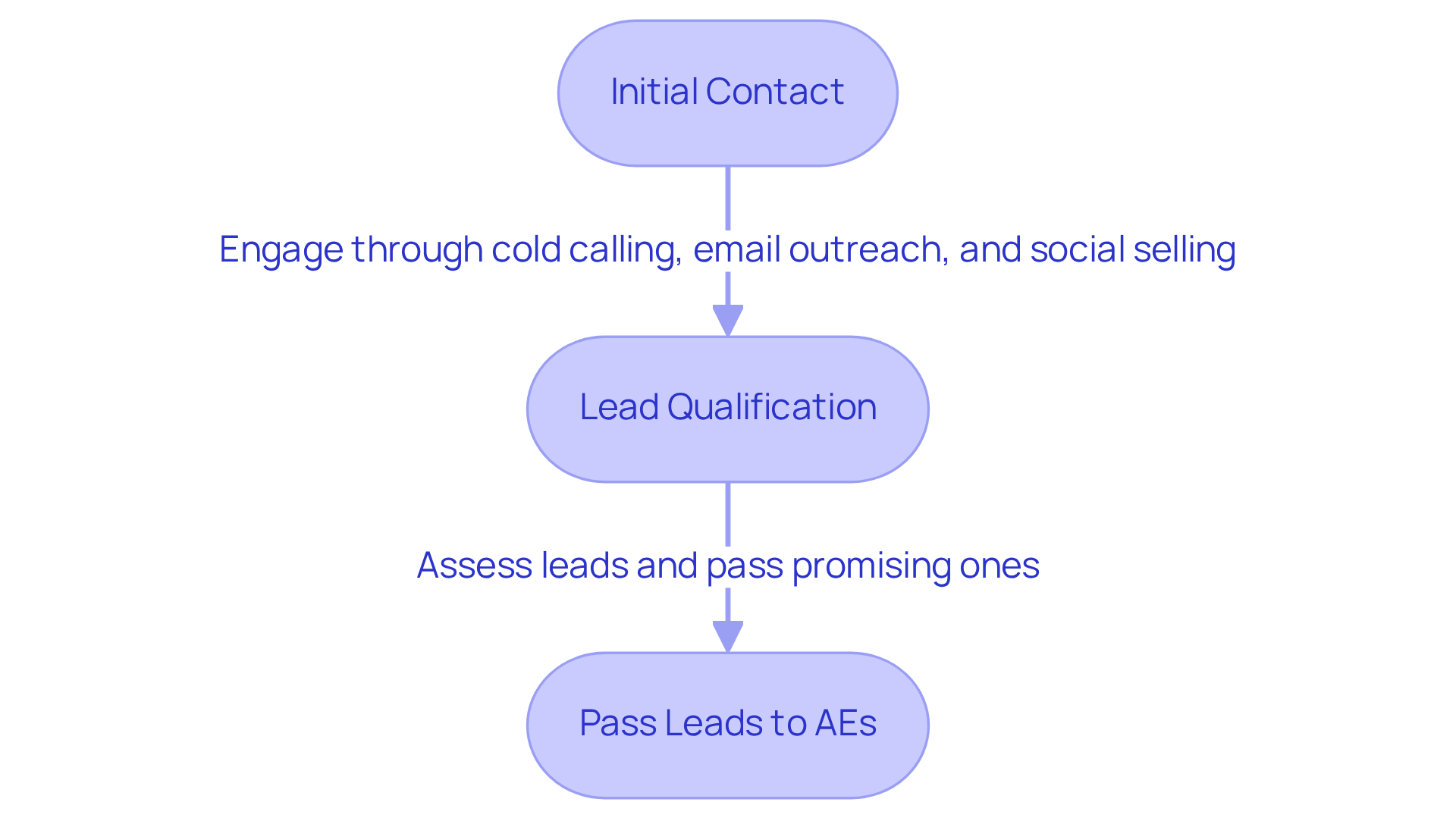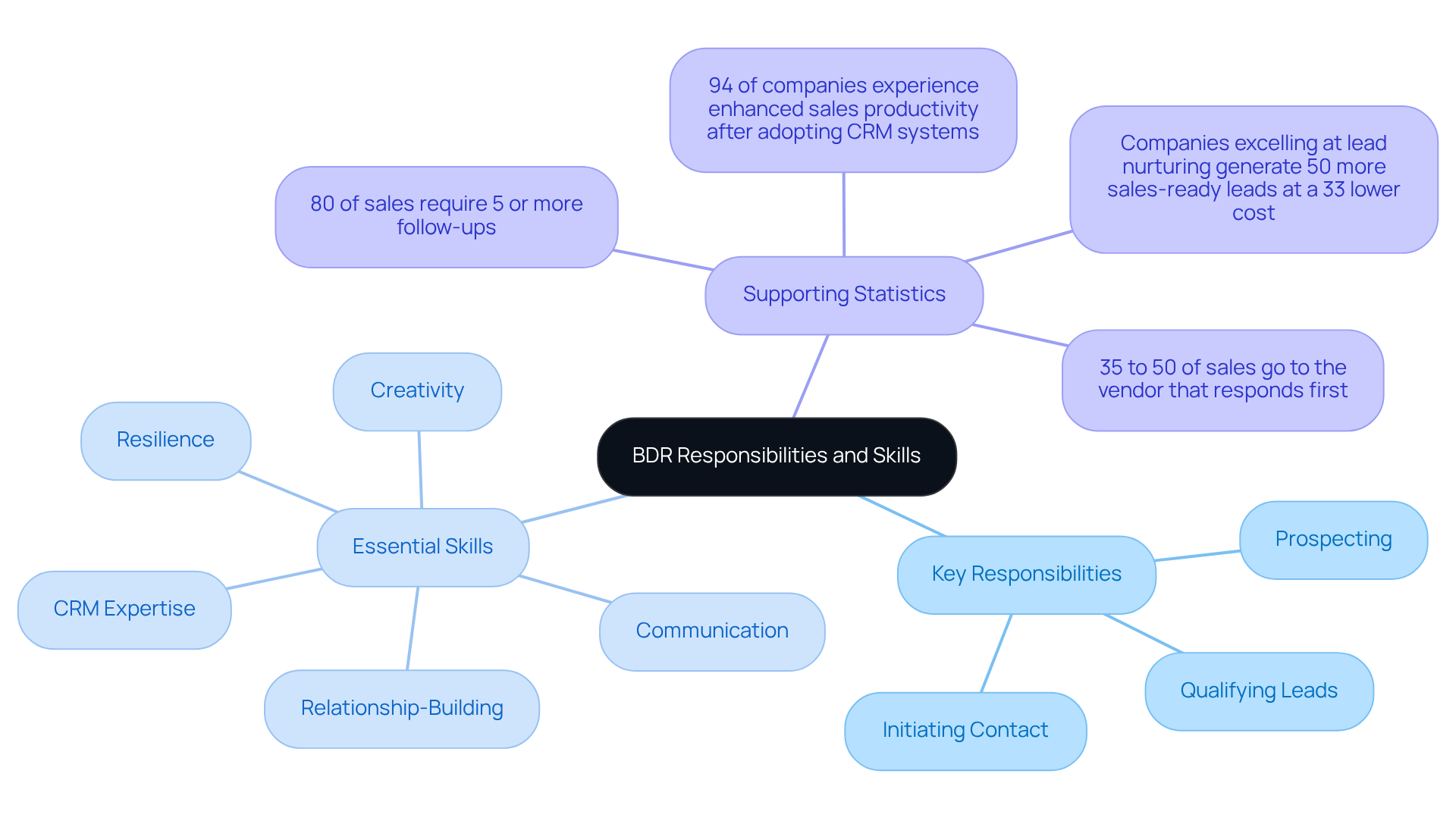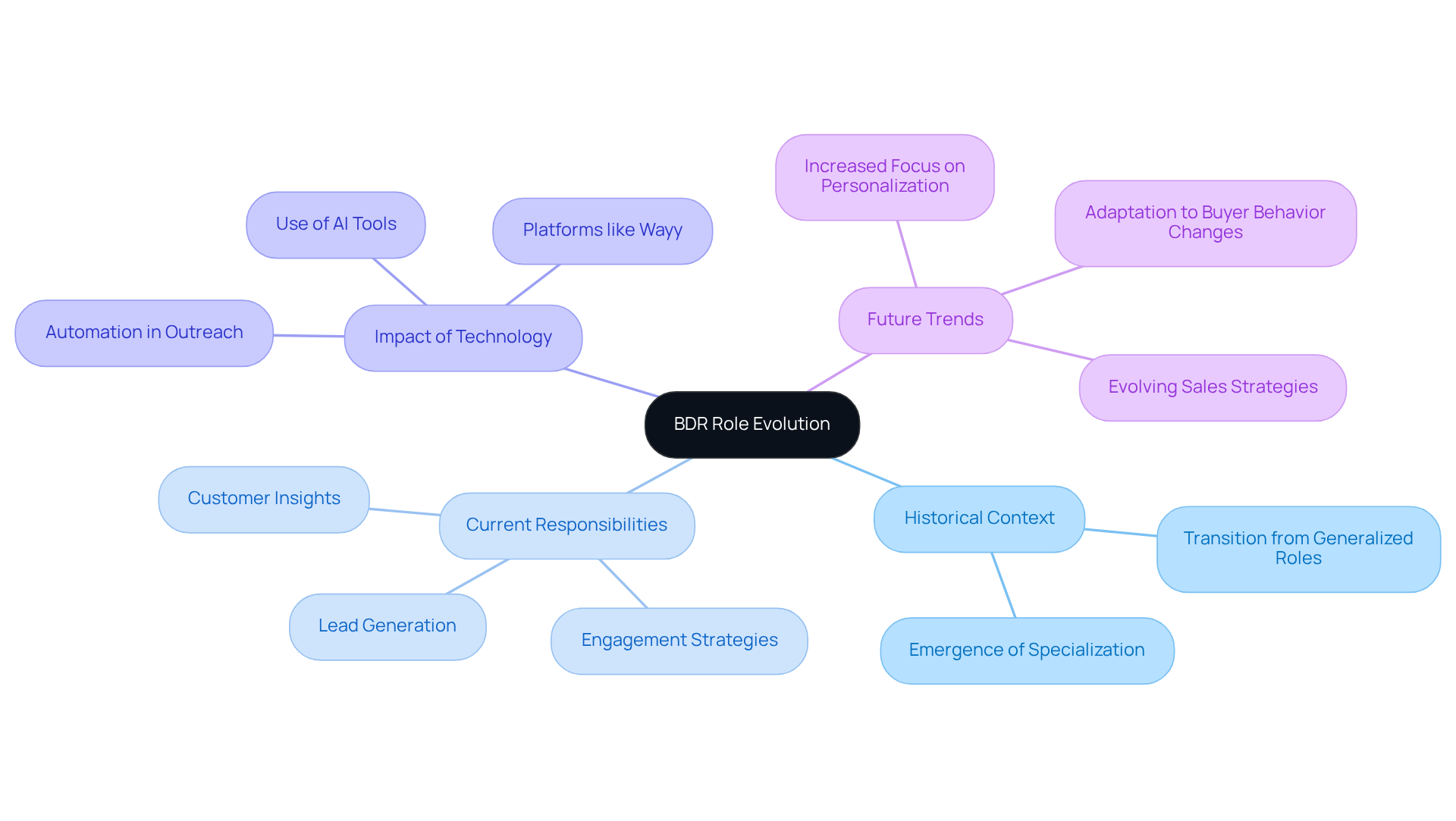Overview
Have you ever wondered how to effectively generate new business opportunities? The term BDR, or Business Development Representative, is key to this process. BDRs focus on prospecting, qualifying leads, and reaching out to potential clients, making them essential players in the sales journey.
Understanding the responsibilities and skills of BDRs can illuminate their critical role in driving revenue growth and enhancing sales efficiency. With the impact of technology, BDRs are more equipped than ever to connect with prospects in meaningful ways.
By recognizing the importance of BDRs, we can appreciate their contribution to a thriving business. Together, we can explore how these professionals can help you navigate the challenges of generating leads and closing sales. Remember, you’re not alone in this journey; we understand your challenges and are here to support your success.
Introduction
In today's evolving sales landscape, specialized roles are becoming increasingly vital, with Business Development Representatives (BDRs) leading the charge. These dedicated professionals play a crucial role in generating new business opportunities, serving as the essential bridge between potential clients and account executives. As the demand for effective lead generation grows, we recognize the increasing significance of BDRs and the questions that arise about their core responsibilities and the skills that contribute to their success.
How do BDRs navigate the complexities of the sales process to help their organizations thrive in a competitive marketplace? Together, we can explore these vital aspects and understand how BDRs can make a meaningful impact.
Define the Business Development Representative (BDR)
A Business Development Representative (BDR), which refers to what does BDR stand for, plays an essential role in the revenue process by focusing on creating new business opportunities for their organization. BDRs are primarily involved in the initial phases of transactions, which include prospecting, opportunity qualification, and initial outreach. Their main goal is to fill the pipeline with qualified leads that can be transformed into clients by account executives (AEs). This function is crucial for ensuring that the marketing team has a steady stream of potential clients, a fundamental aspect of .
In 2025, a significant percentage of companies are employing BDRs as part of their sales teams, recognizing the immense value they bring in establishing a robust sales foundation. Key functions of a BDR encompass:
- Identifying potential opportunities through research
- Engaging with prospects to gauge interest
- Nurturing relationships to facilitate smoother transitions to AEs
Effective BDR strategies in small enterprises often include leveraging technology and data-driven insights, such as those provided by Wayy.ai, to enhance engagement efforts. For instance, with daily email updates tracking key metrics like leads reached, interest shown, and conversion rates, business development representatives can adjust their outreach strategies based on real-time data, ensuring their communications remain relevant and impactful.
Expert insights emphasize the significance of business development representatives in creating business opportunities. Their proactive strategy not only fills the revenue pipeline but also enhances overall sales efficiency. By concentrating on developing connections and understanding client needs, business development representatives play a vital role in the long-term success of commercial initiatives. Together, we can navigate these challenges and achieve success, ensuring that your business thrives in a competitive landscape.

Contextualize BDR in the Sales Framework
In the sales framework, (BDRs) are often the first point of contact for potential clients, which leads to the question of what does BDR stand for, and they play a vital role in lead generation. We understand how challenging it can be to navigate these early stages, which is why BDRs, or what does BDR stand for, work closely with marketing teams to identify target markets and develop effective engagement strategies. Engaging in activities such as cold calling, email outreach, and social selling, BDRs spark interest in their company's offerings, creating opportunities for meaningful connections.
By qualifying leads and nurturing relationships, BDRs, which is what does BDR stand for, ensure that only the most promising prospects are passed on to Account Executives (AEs), who specialize in closing deals. This division of labor not only enhances the efficiency of the sales process but also allows both BDRs and AEs to maximize their effectiveness. For small businesses, effective engagement strategies often incorporate personalized communication and timely follow-ups, which are essential for building rapport and trust with potential clients.
Moreover, the integration of AI tools like Wayy.ai has been shown to boost productivity for 62% of business development representatives. This highlights the significant impact technology can have on their efficiency. With Wayy.ai's daily email insights, BDRs can track key metrics such as leads reached, interest shown, and conversion rates, which further strengthens their engagement efforts. Additionally, features like the one-click sales guide and focused engagement help BDRs streamline their client acquisition processes.
Overall, business development representatives, or BDRs, are achieving an impressive average quota attainment of 88%, which makes one wonder what does BDR stand for. This statistic underscores their crucial role in driving sales success. Together, we can navigate these challenges and work towards achieving our goals.

Outline Key Responsibilities and Skills of a BDR
In today’s competitive landscape, understanding what does BDR stand for is crucial as the role of a Business Development Representative (BDR) is pivotal. They are responsible for:
- Prospecting new opportunities
- Qualifying these leads based on specific criteria
- Initiating contact through various outreach methods
Strong communication skills are not just important; they are essential, especially considering what does BDR stand for, as these professionals often serve as the first point of contact for potential clients. We understand the challenges you face in building these connections, and expertise in CRM software can significantly ease this process. In fact, data shows that:
- 94% of companies experience enhanced sales productivity after adopting CRM systems
- 92% recognize CRM software as a vital component in generating more revenue and higher profits
Moreover, resilience and creativity in outreach strategies are key traits for BDRs, prompting the inquiry of what does BDR stand for. They must possess the ability to analyze market trends to identify potential opportunities. Relationship-building is equally crucial, allowing BDRs to cultivate trust and rapport with prospects, leading one to ask, what does BDR stand for? This trust is essential for achieving effective commercial results. Did you know that firms excelling in lead nurturing produce at a 33% reduced cost? This statistic underscores the importance of these skills in driving revenue success.
As Uvaro aptly states, "A good BDR needs to know everything there is to know about their product, their industry, and their customers." Quickness in the transaction process is also vital; studies reveal that 35% to 50% of deals go to the supplier that responds first. Ultimately, it’s important to remember that 80% of transactions require five or more follow-ups. This highlights the resilience and persistence that BDRs must embody in their roles. Together, we can navigate these challenges and achieve success in your business development efforts.

Trace the Evolution and Importance of the BDR Role
The role of the Business Development Representative (BDR) has undergone a remarkable transformation, which raises the question of what does BDR stand for in the context of the rise of digital marketing and automation tools. Initially, commercial roles were more generalized, but as businesses recognized the necessity for specialized functions, emerged, leading to the question of what does BDR stand for in terms of prospect generation and qualification. This evolution mirrors a broader trend in sales towards specialization, where distinct roles are designed to enhance efficiency and effectiveness.
Today, business development representatives are seen as vital contributors to a company's growth strategy, which raises the question: what does BDR stand for? They not only generate leads but also offer valuable insights into customer needs and market dynamics. Their adaptability to new technologies is crucial. For instance, 60% of business development representatives report that AI tools significantly enhance their productivity. Platforms like Wayy, which provide AI-driven client acquisition for just $99/month, simplify processes for small business owners, enabling them to achieve tangible results without needing extensive sales experience.
Moreover, case studies illustrate how business development representatives effectively utilize digital marketing techniques to engage prospects, ensuring that outreach efforts are both relevant and impactful. As the sales landscape continues to evolve, the significance of BDRs in shaping future sales strategies cannot be overstated. Together, we can navigate these changes and embrace the opportunities that lie ahead.

Conclusion
The role of a Business Development Representative (BDR) is not just integral to the sales process; it serves as a vital connection for creating new business opportunities. By focusing on prospecting, lead qualification, and nurturing relationships, BDRs lay the essential groundwork for successful sales conversions. Their proactive approach not only fills the sales pipeline but also enhances the overall efficiency of the sales team, making them truly indispensable in today’s competitive landscape.
Throughout this article, we have explored key aspects of the BDR role, including their responsibilities in:
- Identifying potential clients
- Engaging through various outreach methods
- Utilizing technology to optimize their efforts
The evolution of the BDR position reflects a broader trend towards specialization within sales, emphasizing the importance of adaptability and strategic thinking. Statistics highlight their effectiveness, with an impressive quota attainment rate underscoring their significant impact on revenue growth.
In conclusion, recognizing the importance of BDRs is essential for any organization aiming to thrive in the sales arena. As businesses continue to evolve, embracing the BDR model can lead to enhanced lead generation and a more streamlined sales process. For organizations looking to boost their sales performance, investing in skilled BDRs and leveraging technology can create meaningful opportunities for growth and success. Together, we can navigate these challenges and achieve remarkable results.
Frequently Asked Questions
What is the role of a Business Development Representative (BDR)?
A Business Development Representative (BDR) focuses on creating new business opportunities for their organization by engaging in prospecting, opportunity qualification, and initial outreach to fill the sales pipeline with qualified leads.
Why are BDRs important for companies?
BDRs are crucial for ensuring that the marketing team has a steady stream of potential clients, which is fundamental for promoting revenue growth. They help establish a robust sales foundation by identifying and nurturing leads.
What are the key functions of a BDR?
The key functions of a BDR include identifying potential opportunities through research, engaging with prospects to gauge interest, and nurturing relationships to facilitate smoother transitions to account executives (AEs).
How do BDRs utilize technology in their strategies?
BDRs often leverage technology and data-driven insights to enhance engagement efforts. For example, they may use tools like Wayy.ai to track key metrics such as leads reached, interest shown, and conversion rates, allowing them to adjust their outreach strategies based on real-time data.
What impact do BDRs have on sales efficiency?
BDRs enhance overall sales efficiency by proactively filling the revenue pipeline and developing connections with prospects. Their understanding of client needs contributes to the long-term success of commercial initiatives.
What is the future outlook for BDRs in companies?
By 2025, a significant percentage of companies are expected to employ BDRs as part of their sales teams, recognizing the immense value they bring in establishing a strong sales foundation.




